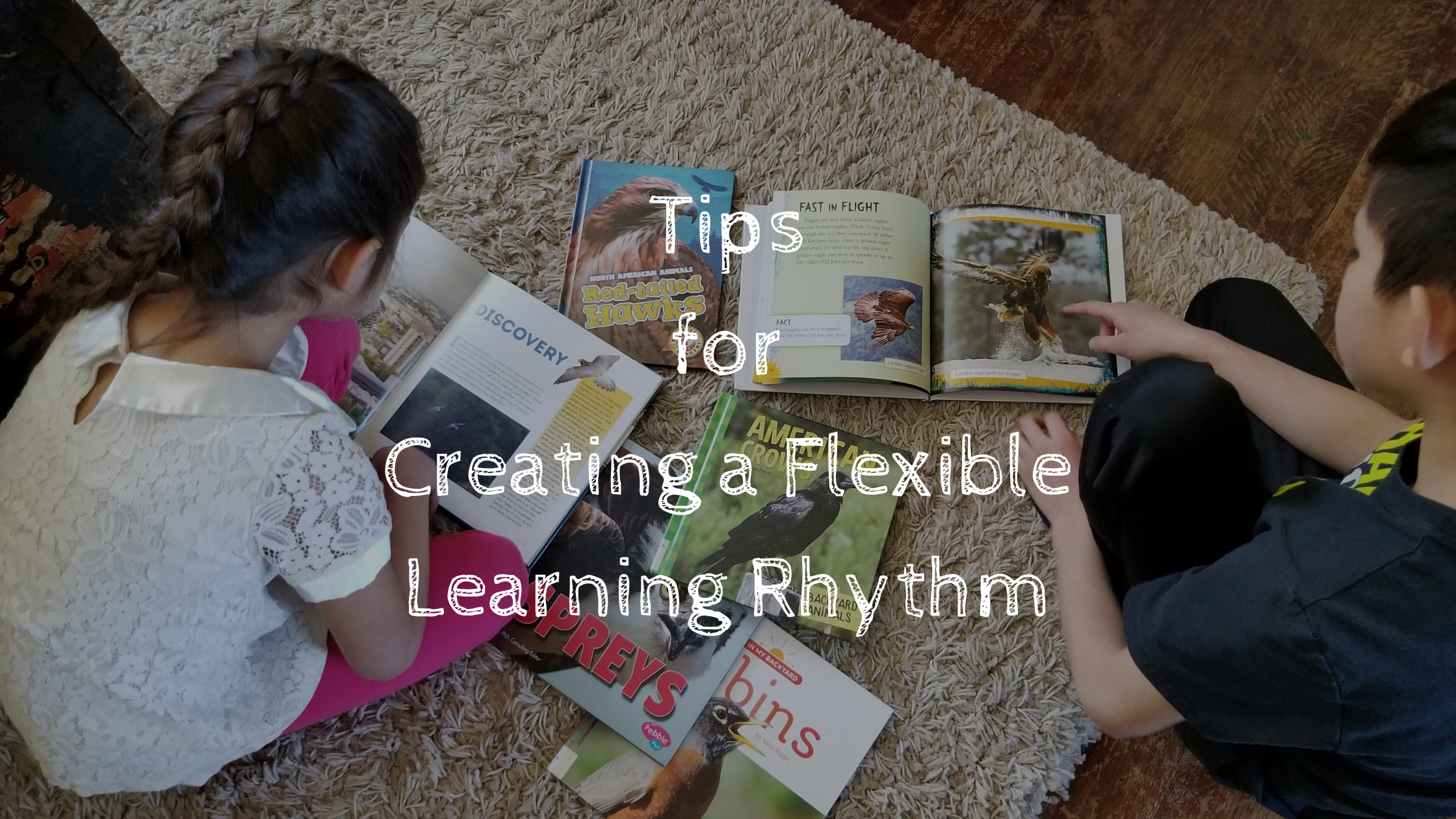Tips for Creating a Flexible Learning Rhythm

Have you ever come up with the perfect homeschool schedule … only to abandon it by Wednesday?
Maybe you printed out a color-coded chart or followed someone else’s routine, hoping it would bring peace and productivity – but instead, it left you feeling behind, stressed, and discouraged.
That was ME in my early years as a homeschool mama! But here’s the truth no one tells you loudly enough, and what I had to figure out over time: you don’t need a rigid schedule to homeschool well.
In fact, real peace and progress in our home came when I learned to release tightly packed lesson plans and instead work with our family’s natural rhythm – one that flowed with our family’s natural energy, was intentional yet flexible, and prioritized connection over control.
If you’re ready to let go of the pressure and build a rhythm that works with your family (not against it), one that allows learning to unfold in a more life-giving way, here are some simple, practical tips to help you get started. Pick the ones that fit your family best!
OBSERVE YOUR FAMILY’S ENERGY PATTERNS
Some kids (and mamas!) are alert in the morning; others bloom in the afternoon. Take this into account to capitalize on making your activities count. You can ask yourself:
- When is my child most curious?
- When do I feel most patient and available?
- When does everyone need rest or alone time?
Let energy guide your “learning windows” rather than the clock or a schedule in a teacher’s guide.
START WITH ANCHORS, NOT STRICT HOURS
Your anchors are your daily recurring activities – meals, chore time, quiet time, outside time, etc. and establishing a routine based on what you are already doing will be easier to stick to than creating a schedule just because it sounds good or productive.
An example of building a rhythm around you anchors could like:
- Breakfast + Bible Anchor: Most everyone eats breakfast so start off your family’s day with fueled BOTH by food and the word of God
- Morning Anchor: Chores, free play, or interest-led pursuits
- Lunch + Literature Anchor: Take advantage of kids eating by reading out loud!
- Afternoon Anchor: Outside time/nature walk, errands, library, or quiet time activities
- Dinner + Dialogue: Spend time as a family talking about your day – things you did, things you learned, questions you have, etc.
CREATE A LOOSE FLOW, INSTEAD OF A TIGHT PLAN
Maybe you do come up with your “ideal flow” for the day, but hold it loosely. Think of it like a river – steady, but flexible.
Here’s an example for this tip:
- Morning: chores (so you intentionally carved out time for maintaining the home God gave you) followed by creativity (drawing, storytelling, Legos)
- Late morning: go to the park or run errands
- After lunch: read-aloud or explore a question you child had from earlier in the day
- Afternoon: free time / passion projects / screen time
- Before bed: family connection / journaling / prayer
ROTATE FOCUS AREAS, INSTEAD OF DOING EVERY SUBJECT DAILY
Many families do work a “loop” or rotate learning activities instead of squeezing it all in every single day.
For example:
- Monday: Nature Study, Science Exploration
- Tuesday: Practical Life Skills, Math Games
- Wednesday: Literature, Poetry, Art, Music
- Thursday: Entrepreneurship, Leadership Skills
- Friday: Field Trip, Free Choice
This is way of doing things is less stressful; if you skip a day, just pick up where you left off!
LET INTERESTS LEAD AND TRUST THE DEEP DIVES
If your kiddo is into animals, Legos, WWII, baking, or bugs, lean in! Deep interest-led learning often covers multiple “subjects” at once: reading/research (language arts), measuring/tracking/building (math, history, science, life skills … all bundled into their passion!
This happened over and over again in our homeschool whether my kids were into Minecraft, horses, Barbies, zoo animals, etc. When they were diving deep into things they were interested in, it was even difficult to get them to take breaks or eat meals! We had many days and weeks where all it looked like was my kids being consumed by whatever the “thing” was. But, here’s the thing: freedom means trusting that learning is happening even when it doesn’t look academic.
BUILD IN MARGIN
Overwhelm often comes when we over-plan and don’t create room for “white space” in our daily activities. Make sure to leave room for:
- Boredom (actually, that’s often where creativity blooms!)
- Conversations
- Rabbit trails
- Rest
Even God built in a Sabbath, and our homeschools need rhythms of rest too.
REVISIT AND ADJUST OFTEN
I want to remind you that you’re not failing if your rhythm stops working. One thing I’ve learned as a 14+ year homeschool mom is that the CONSTANT is CHANGE! As soon as we’d find our groove, then a kid would outgrow an interest or another kid would pick up a sport or out-of-the-home activity. It’s 100% okay to change with the seasons, your family’s needs, or your kids’ growth.
One question you can ask yourself monthly: “What’s giving life right now? What’s draining us?” Then go from there!
I hope these tips are helpful to you as you try to come up with your own family rhythm that supports natural, interest-led learning!
If you need even more concrete ideas, I do share about what works for us in this post.
